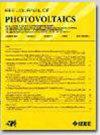异质结硅光伏组件冰雹损伤研究:真实案例研究
IF 2.6
3区 工程技术
Q3 ENERGY & FUELS
引用次数: 0
摘要
大多数光伏(PV)组件的保修期为25-30年。然而,严重的气候事件,特别是冰雹,可能导致过早的破坏。在这篇文章中,意大利帕多瓦的一个住宅光伏系统在遭受了直径达16厘米的冰雹的严重风暴后进行了研究,该冰雹比用于模块验证的测试石头的标准尺寸(根据IEC 61215-2-2021的标准尺寸为7.5厘米)大两倍多。目标是:1)证明冰雹测试的相关性超出了目前标准的要求;2)即使在没有碎玻璃或性能下降的情况下,证明存在潜在损害;3)讨论相关风险。为了尽量减少环境影响的影响,在黑暗中进行了正向偏置电致发光(EL)和红外(IR)辐射研究。在最坏的情况下,完全的玻璃破碎会导致太阳能电池破碎,从而导致电流和热辐射的不均匀,增加损耗,损害电绝缘,并需要立即更换。此外,在黑暗和室外的光电流-电压特性中,输出功率明显下降,漏电流增加。值得注意的是,通过降低的EL强度和更高的IR辐射可以检测到潜在或不可见的损伤,即使在保护玻璃能够承受冰雹机械冲击的模块中,也会带来安全问题。与完全完整的模块相比,具有完整玻璃的模块表现出降低的分流电阻,输出功率的降低可以忽略不计。研究结果强调了在冰雹后对整个光伏系统进行检查的必要性,以发现任何潜在的损坏并及时更换损坏的模块,即使没有玻璃破裂或输出功率降低,也可以确保长期可靠性。本文章由计算机程序翻译,如有差异,请以英文原文为准。
Hail Damage Investigation in Heterojunction Silicon Photovoltaic Modules: A Real-World Case Study
Most photovoltaic (PV) modules are guaranteed for 25–30 years. However, severe climatic events, particularly hail, can lead premature damage. In this article, a residential PV system in Padova, Italy, was studied after exposure to a severe storm with hailstones up to 16 cm in diameter, which is more than two times larger than the standard size of test stones employed for module validation (7.5 cm, as per IEC 61215-2-2021). The goals are: 1) to demonstrate the relevance of hail testing beyond what currently required by the standards; 2) to demonstrate the presence of latent damage even in the absence of broken glass or of reduced performance; and 3) to discuss the associated risks. Forward bias electroluminescence (EL) and infrared (IR) radiation investigations were conducted in dark to minimize the impact of environmental influences. In the worst case, complete glass breakage results in solar cell fragmentation, which induces nonuniformity in current flow and thermal radiation, increasing losses, compromising electrical insulation, and requiring immediate replacement. In addition, dark and outdoor light current–voltage characteristics reveal significant decrease in output power, as well as increased leakage current. Remarkably, latent or invisible damage, detectable by reduced EL intensity and higher IR radiation, poses safety issues even in modules whose protective glass withstood the mechanical impact of hail. Modules with intact glass exhibit a decreased shunt resistance, with a negligible reduction in the output power with respect to a completely intact module. The results underline the necessity of inspecting the entire PV system following hailstorms, to detect any latent damages and promptly replace the damaged modules, even in the absence of glass breakage or reduction in the output power, to ensure long-term reliability.
求助全文
通过发布文献求助,成功后即可免费获取论文全文。
去求助
来源期刊

IEEE Journal of Photovoltaics
ENERGY & FUELS-MATERIALS SCIENCE, MULTIDISCIPLINARY
CiteScore
7.00
自引率
10.00%
发文量
206
期刊介绍:
The IEEE Journal of Photovoltaics is a peer-reviewed, archival publication reporting original and significant research results that advance the field of photovoltaics (PV). The PV field is diverse in its science base ranging from semiconductor and PV device physics to optics and the materials sciences. The journal publishes articles that connect this science base to PV science and technology. The intent is to publish original research results that are of primary interest to the photovoltaic specialist. The scope of the IEEE J. Photovoltaics incorporates: fundamentals and new concepts of PV conversion, including those based on nanostructured materials, low-dimensional physics, multiple charge generation, up/down converters, thermophotovoltaics, hot-carrier effects, plasmonics, metamorphic materials, luminescent concentrators, and rectennas; Si-based PV, including new cell designs, crystalline and non-crystalline Si, passivation, characterization and Si crystal growth; polycrystalline, amorphous and crystalline thin-film solar cell materials, including PV structures and solar cells based on II-VI, chalcopyrite, Si and other thin film absorbers; III-V PV materials, heterostructures, multijunction devices and concentrator PV; optics for light trapping, reflection control and concentration; organic PV including polymer, hybrid and dye sensitized solar cells; space PV including cell materials and PV devices, defects and reliability, environmental effects and protective materials; PV modeling and characterization methods; and other aspects of PV, including modules, power conditioning, inverters, balance-of-systems components, monitoring, analyses and simulations, and supporting PV module standards and measurements. Tutorial and review papers on these subjects are also published and occasionally special issues are published to treat particular areas in more depth and breadth.
 求助内容:
求助内容: 应助结果提醒方式:
应助结果提醒方式:


